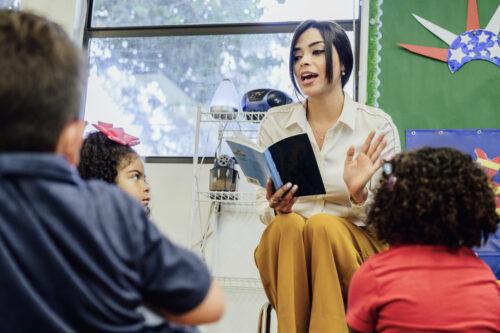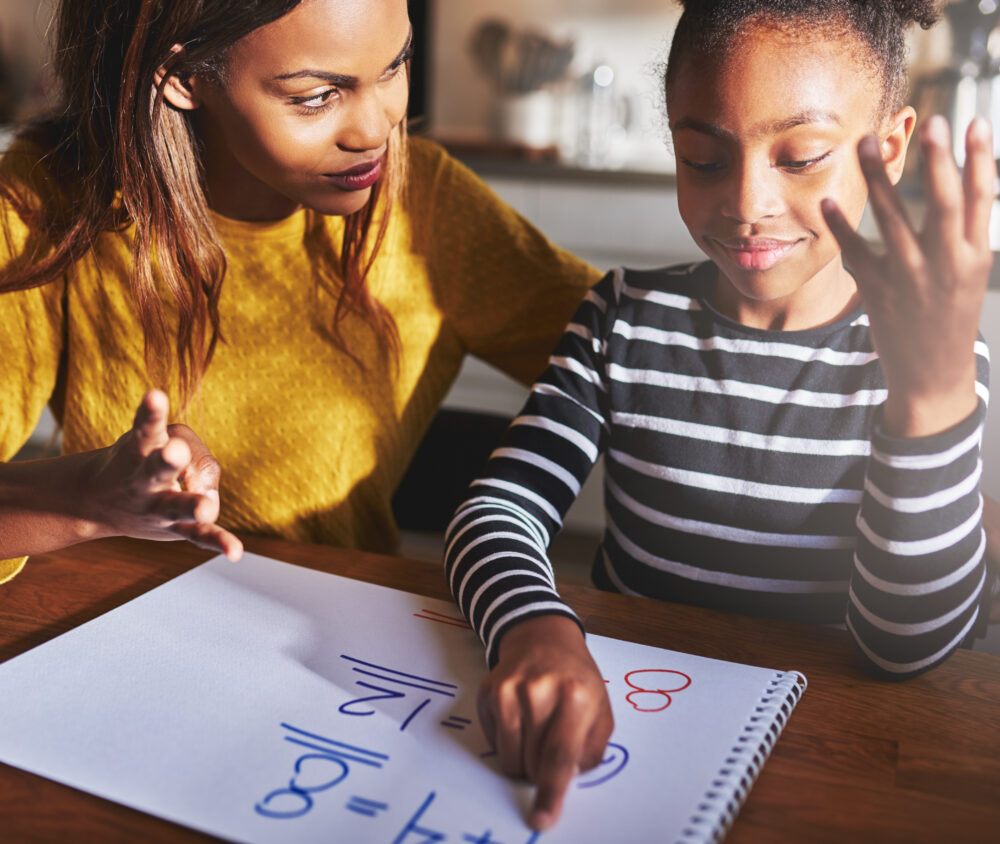
Teachers Are the Key to Student Success
In Justice Seekers, UnboundEd CEO Lacey Robinson highlights a critical truth: teachers are the key factor in student achievement. Teacher knowledge and pedagogy impact students more than any other school-related factor, including leadership (Opper, 2019). Robinson underscores that just as doctors and lawyers act armed with a wealth of concepts, pedagogy, and context, educators must also know which tools to draw upon to ensure they center students in a learning process with grade-level expectations. Teachers are most effective when equipped with the knowledge, tools, and skills to move students forward.
What is grade-level instruction?
UnboundEd works with educators at every level of the system to provide students with grade-level, engaging, affirming, and meaningful — GLEAM® — instruction. Grade-level instruction allows all students the opportunity to grapple with grade-level texts and tasks, with support provided as needed.
To teach at grade level, educators must use texts, tasks, and materials matching grade-level standards for college and career readiness, and instruction should maintain the demands of the grade-level standards.
When educators provide students with supportive access to progressively higher-level expectations, students gain the skills and knowledge to make their own choices about their future. Grade-level materials and instruction are essential for creating a tier 1 space where learning can be engaging, affirming, and meaningful. If we don’t begin with grade-level expectations, instruction, and support, how can we ever deliver effective learning experiences that open opportunities for students’ futures?
Who gets grade-level instruction?
In The Opportunity Myth, TNTP reported that although 82% of teachers agreed with their state’s academic standards, only 44% believed their students could meet them (TNTP, 2018). This belief likely drove another finding in the report — less than one-third of classroom time addressed grade-level instruction and assignments (TNTP, 2018). Said another way, teachers spent most classroom time on below-grade-level instruction and assignments. We know this is unacceptable. To ensure students meet grade-level expectations, we must prioritize grade-level learning.
What does grade-level instruction look like?
To plan and provide grade-level instruction, it is essential to:
- Keep tasks focused on grade-level expectations.
- Use grade-level texts.
- Choose suitable materials to support student learning.
Let’s look at some examples that illustrate each of these.
Keep tasks focused on grade-level expectations, especially if you adjust the lesson.
We must attend to the language of the standards to understand the nuances of what each standard calls for students to do. Knowing what the standards require at, above, and below grade level means we can ensure that instructional strategies match the intent of the grade-level standard. For example, consider this vignette:
To address the ELA Standard RL.4.2 (“Determine a theme of a story, drama, or poem from details in the text; summarize the text.”) two fourth-grade teachers, Ms. Pol and Mr. Shea, ask their classes to find the main theme in Gare Thompson’s play Divided Loyalties and give evidence from the text for their argument.
Ms. Pol gives her student groups four possible themes to choose from. She directs them to decide on the strongest theme and provides details to support their choice. Mr. Shea assigns each student group a theme and asks them to identify supporting details.
Which teacher’s task maintains grade-level demands?
If you said Ms. Pol, you’re right. She asks her students to determine and argue for a theme themselves, encouraging critical thinking. Mr. Shea’s class supports a provided theme, which doesn’t encourage the same level of critical thinking.
Use grade-level texts.
With appropriate support, students can access the texts written to meet grade-level expectations, not texts altered or summarized to a lower level of complexity. For example, consider this vignette:
Two middle school science teachers, Ms. Brither and Ms. Coopin, prepare a lesson on how body systems work together to keep us healthy. This lesson targets the standard MS-LS1-3, “Use evidence to show how the body is made of interacting subsystems composed of cells.” Both teachers know the texts are complex and challenging.
To help her students, Ms. Brither adds a written summary at the top of each article. Ms. Coopin, on the other hand, uses “close reading” with her students on one of the texts. Then, the students work in pairs to use the same close-reading strategy on the other articles.
Which teacher’s use of text addresses the grade-level standard?
If you said Ms. Coopin, you are right. She teaches her students a strategy they can use. She supports them in summarizing but doesn’t do the work for them.
Choose the right materials.
To meet grade-level expectations, students must use the specific tools or materials called for in the standards. This demand might require providing tools and manipulatives in math or various forms of media in ELA and Science. Consider the following vignette:
Two high school math teachers, Mrs. Rogers and Ms. Newfell, teach a geometry lesson on standard HSG.CO.A.5, which involves transforming geometric figures and states, “Given a geometric figure and a rotation, reflection, or translation, draw the transformed figure using, e.g., graph paper, tracing paper, or geometry software. Specify a sequence of transformations that will carry a given figure onto another.”
Mrs. Rogers gives students graph paper, tracing paper, and modeling software. Students work in pairs to transform figures and write two or three possible sequences for the transformations. Ms. Newfell models a transformation on a smart screen, and students record the sequence.
Which teacher uses materials most effectively?
If you said Mrs. Rogers, you’re right. She provides tools for students to practice the transformations themselves.
How do I bring grade-level instruction to life?
Grade-level instruction is foundational to tier 1 GLEAM instruction. Grade-level is where instruction begins. When the intent of adaptations is to foster student engagement, ensure student affirmation, or make meaningful connections, they must stay within the context of grade-level instruction. Adaptations that don’t maintain the demands of the standards deny students access to college and career readiness by gatekeeping grade-level content. To hold the grade-level line:
- Believe that students can succeed at grade-level learning with appropriate support.
- Use a grade-level curriculum with appropriate training and support. Execute lessons focused on the demands of the grade-level standards. Adapt in ways that maintain those demands.
- Examine how lesson tasks, texts, and materials align with grade-level expectations. Review the language of the standards that are associated with the lesson objectives.
- Plan lessons that ensure all students experience grade-level texts, tasks, and materials. Use student work to measure the effectiveness of your instruction and student performance.
Lacey Robinson asserts, “We do not often talk about doctors, teachers, and lawyers in the same breath.” We should. Our work as educators, the work of raising the next generation, is as important, difficult, and impactful as that of our colleagues in other professions. Making sure students move through a continuum of grade-level instruction is key to their success and tied directly to ours.
Be sure to check out the blogs below to learn more about the other elements of GLEAM instruction.
Read About the Elements of GLEAM Instruction


Affirming Instruction: Creating Safe, Supported, and Immersive Learning Environments

Meaningful Instruction: Fostering Critical Thinking, Advocacy, and Change in the Classroom
References
National Governors Association Center for Best Practices & Council of Chief State School Officers. (2010).
Common Core State Standards for English language arts and literacy in history/social studies, science, and technical subjects. Washington, DC.
National Governors Association Center for Best Practices & Council of Chief State School Officers. (2010).
Common Core State Standards for Mathematics. Washington, DC.
National Research Council. (2013). Next generation science standards: For states, by states.
Opper, I. M. (2019). Teachers matter: Understanding teachers’ impact on student achievement.
Robinson, L. (2023). Justice Seekers: Pursuing Equity in the Details of Teaching and Learning.
Next steps with GLEAM®
Choose the path that fits your team

Standards Institute™
At Standards Institute, educators cultivate the mindsets, skill sets, and tools to provide grade-level, engaging, affirming, and meaningful instruction.
Learn More ➜
UnboundEd Summits
Accelerate your instructional vision and build educators’ skills and expertise with a virtual or on-site Local Summit.
Learn More ➜

In-Service Workshops
UnboundEd’s dynamic, hands-on workshops build educator capacity by focusing on timeless, cross-disciplinary instructional moves that drive effective instruction, rigor, and student empowerment.
Learn More ➜
Online Math Academy
UnboundEd’s Online Math Academy courses enrich educators’ content knowledge and instructional practices to unlock all students’ math potential.
Learn More ➜
Curriculum Adoption
Ensuring quality materials are adopted and used effectively is crucial to improving outcomes and requires a strong instructional materials selection process. We’re here to share guidance and support on leading a rigorous and collaborative curriculum adoption process to select the right materials for your context and goals.
Learn More ➜
Curriculum Implementation
Just getting started, or need to get back on track? We work with you on a shared vision and an actionable plan for curriculum success.
Learn More ➜
Literacy ReclaimEd
Improve literacy instruction and better meet the unique needs of every student.
Learn More ➜
GLEAM® Inventory
Build your team’s understanding of grade-level, engaging, affirming, and meaningful –GLEAM®– instruction and transform how you serve all students in your district.
Learn More ➜
Speaking Engagements
Our experts offer inspiring, thought-provoking messages and conversations that will get your team thinking creatively about shifting mindsets and changing practice.
Learn More ➜
California Math Curriculum Adoption and Launch Cohort
Prepare to adopt and launch high-quality mathematics instructional materials with no-cost, grant-funded support from UnboundEd.
Learn More ➜